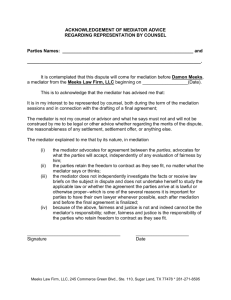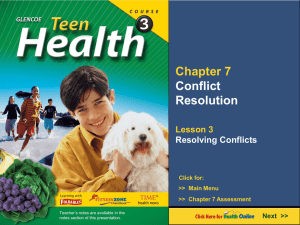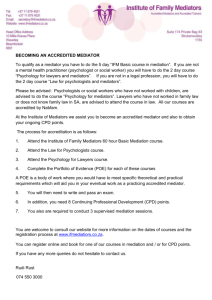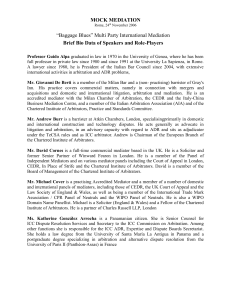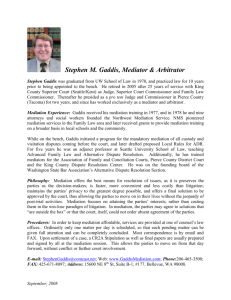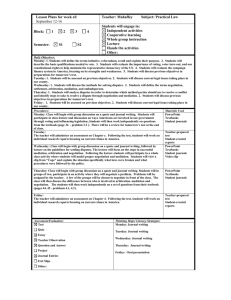The Real World Code of Ethics: Practices and Dilemmas
advertisement
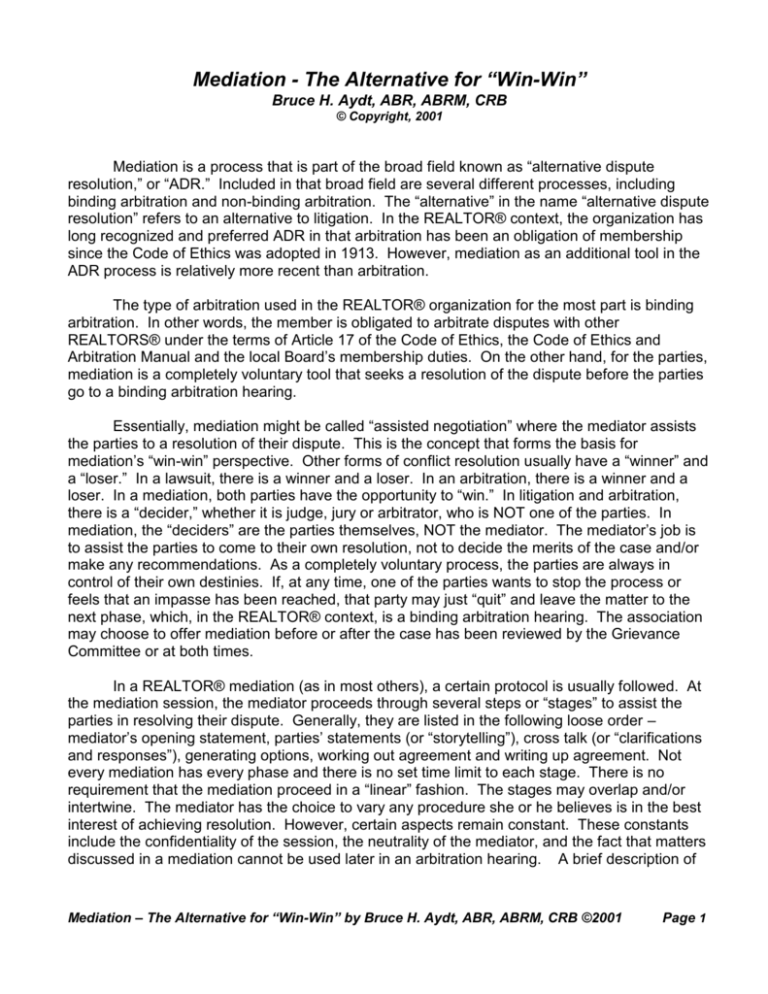
Mediation - The Alternative for “Win-Win” Bruce H. Aydt, ABR, ABRM, CRB © Copyright, 2001 Mediation is a process that is part of the broad field known as “alternative dispute resolution,” or “ADR.” Included in that broad field are several different processes, including binding arbitration and non-binding arbitration. The “alternative” in the name “alternative dispute resolution” refers to an alternative to litigation. In the REALTOR® context, the organization has long recognized and preferred ADR in that arbitration has been an obligation of membership since the Code of Ethics was adopted in 1913. However, mediation as an additional tool in the ADR process is relatively more recent than arbitration. The type of arbitration used in the REALTOR® organization for the most part is binding arbitration. In other words, the member is obligated to arbitrate disputes with other REALTORS® under the terms of Article 17 of the Code of Ethics, the Code of Ethics and Arbitration Manual and the local Board’s membership duties. On the other hand, for the parties, mediation is a completely voluntary tool that seeks a resolution of the dispute before the parties go to a binding arbitration hearing. Essentially, mediation might be called “assisted negotiation” where the mediator assists the parties to a resolution of their dispute. This is the concept that forms the basis for mediation’s “win-win” perspective. Other forms of conflict resolution usually have a “winner” and a “loser.” In a lawsuit, there is a winner and a loser. In an arbitration, there is a winner and a loser. In a mediation, both parties have the opportunity to “win.” In litigation and arbitration, there is a “decider,” whether it is judge, jury or arbitrator, who is NOT one of the parties. In mediation, the “deciders” are the parties themselves, NOT the mediator. The mediator’s job is to assist the parties to come to their own resolution, not to decide the merits of the case and/or make any recommendations. As a completely voluntary process, the parties are always in control of their own destinies. If, at any time, one of the parties wants to stop the process or feels that an impasse has been reached, that party may just “quit” and leave the matter to the next phase, which, in the REALTOR® context, is a binding arbitration hearing. The association may choose to offer mediation before or after the case has been reviewed by the Grievance Committee or at both times. In a REALTOR® mediation (as in most others), a certain protocol is usually followed. At the mediation session, the mediator proceeds through several steps or “stages” to assist the parties in resolving their dispute. Generally, they are listed in the following loose order – mediator’s opening statement, parties’ statements (or “storytelling”), cross talk (or “clarifications and responses”), generating options, working out agreement and writing up agreement. Not every mediation has every phase and there is no set time limit to each stage. There is no requirement that the mediation proceed in a “linear” fashion. The stages may overlap and/or intertwine. The mediator has the choice to vary any procedure she or he believes is in the best interest of achieving resolution. However, certain aspects remain constant. These constants include the confidentiality of the session, the neutrality of the mediator, and the fact that matters discussed in a mediation cannot be used later in an arbitration hearing. A brief description of Mediation – The Alternative for “Win-Win” by Bruce H. Aydt, ABR, ABRM, CRB ©2001 Page 1 each stage is next. (This description presumes that the dispute is a procuring cause dispute concerning a commission.) Mediator’s Opening Statement: The mediator will begin the mediation session by introducing him/herself and the parties. She will then tell the parties about how a mediation works, its confidentiality aspects and give a brief description of the stages and protocols. The mediator will ask the parties to sign the NAR mediation agreement if they have not yet done so. Parties’ Statements (or “Storytelling”): The mediator will invite one of the parties to begin by “telling their story” - that is, to present their side of the facts and explain why they believe they are entitled to the commission. After they have completed telling their story, the mediator will ask the other party to tell their story. Usually, no questions are being asked between the parties at this time. This stage is simply an opportunity for all parties, including the mediator, to get as complete a picture as possible of the facts. Crosstalk (or “Clarifications and Responses”): This stage is the one in which the parties ask each other questions to clarify any facts which the parties told during storytelling. The mediator may ask questions as well. The parties being asked the questions may respond and clarify their answers. Generating Options: It is this phase that the work of hopeful agreement begins. The mediator can handle this process in any way he sees fit, whether asking the parties whether there had been prior offers or asking whether the parties have any new understandings after hearing the stories and responses or asking whether the parties have any ideas about a fair resolution of the case. It is possible that the mediator may want to give the parties a short break before moving into this stage to allow them to talk among themselves and/or reflect upon what they have heard. This technique is often helpful if either or both sides are comprised of both broker and agent or agents. It allows the broker and agent(s) to discuss any new understandings they may have and to assess or reassess their thoughts about settlement. Ideally, the mediator and the parties would generate a list of possible choices for settlement. Many times, however, the mediator chooses to go to the next stage. Working Out Agreements: This can be the hard work of negotiation. The mediator’s role here is to keep the parties talking about options and assist them in resolving their own dispute. The mediator generally should not comment about the merits of the case or her prediction of the outcome in arbitration. However, the mediator may comment on parts of the respective cases, pointing out how certain facts may fit into the procuring cause factors that panels use, so that the parties may consider this in their decision to settle. Hopefully, this stage ends in an agreement of the parties to resolve the dispute. If there is no resolution, the mediator or the parties will make a decision to end the mediation session. It is possible to agree to continue the matter to another mediation session. If the mediation ends without agreement, the parties will proceed to a binding arbitration hearing. Mediation – The Alternative for “Win-Win” by Bruce H. Aydt, ABR, ABRM, CRB ©2001 Page 2 Writing Up Agreements: If the parties work out an agreement in the previous stage, the mediator will ask the parties to propose appropriate language that reflects the agreement they have reached. The NAR Code of Ethics and Arbitration manual has the appropriate form for the written agreement. When the parties sign the written agreement and make the appropriate payments called for in the agreement, the arbitration is not held and the deposits of the parties are returned. If the parties successfully complete a mediation with an agreement, both can walk away as “winners.” While it is true that both may not have “won” a complete “victory,” the result is only their decision and not that of a third party. This alone is a “victory”. Mediation may resolve up to 75% or 80% of the cases filed. It can and often does result in a more satisfying decision for both parties. It also allows the parties to each preserve future business relationships without the rancor and bad feeling which often can prevail after a lawsuit or arbitration hearing. These intangible factors are icing on the “cake” of the resolution of the agreement and truly make the mediation the “Win-Win Alternative.” Mediation – The Alternative for “Win-Win” by Bruce H. Aydt, ABR, ABRM, CRB ©2001 Page 3
